Global Brands Group Bundle
Who Really Controlled Global Brands Group?
Unraveling the ownership of Global Brands Group (GBG) is crucial for understanding its turbulent journey. The company's story, marked by a trading halt in 2021, offers a compelling case study in corporate governance and market dynamics. This exploration dives deep into the Global Brands Group SWOT Analysis, its evolving ownership structure, and the forces that shaped its destiny.
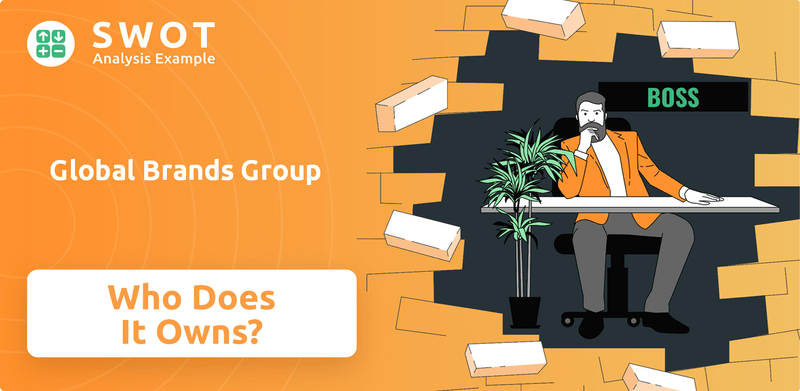
From its origins as a spin-off to its eventual liquidation, the shifts in Global Brands Group ownership reveal much about its strategic decisions and financial health. This analysis examines the influence of key stakeholders, the impact of its brand portfolio, and the changes within its corporate structure. Understanding "Who owns Global Brands Group" provides essential context for assessing its past performance and the future of its remaining assets, offering valuable insights for investors and business strategists alike.
Who Founded Global Brands Group?
The story of Global Brands Group (GBG) began in 2005 as a wholesale division within Li & Fung Limited, focusing on private label and branded apparel. The company's evolution culminated in its spin-off, which established Global Brands Group as a separate entity. This strategic move allowed GBG to operate independently, shaping its own brand portfolio and corporate structure.
Global Brands Group was officially incorporated in Bermuda on December 4, 2013. This was a crucial step in its separation from Li & Fung. The spin-off was finalized on July 9, 2014, when Global Brands Group was listed on the Hong Kong Stock Exchange.
The initial ownership of Global Brands Group was directly tied to the shareholders of Li & Fung. This was achieved through a distribution in specie, where Li & Fung shareholders received shares in Global Brands Group, effectively transferring ownership. Understanding this early ownership structure is key to tracing the company's development.
William Fung, formerly the Chairman of Li & Fung Limited, became the non-Executive Chairman of Global Brands Group.
Bruce Rockowitz, the former CEO of Li & Fung, was appointed as the Chief Executive Officer of the newly formed Global Brands Group.
Key executives at the time of the spin-off included Dow Famulak as President, Ron Ventricelli as Chief Operating Officer, Jason Rabin as Chief Merchandising Manager, and Frank Leong as Chief Financial Officer.
The ownership structure was inherently linked to the shareholders of Li & Fung, ensuring a smooth transition of ownership.
The spin-off was a 100% distribution in specie to Li & Fung shareholders, giving them shares in Global Brands Group.
The initial focus was on building a diverse brand portfolio and establishing a strong corporate structure.
It's important to distinguish the Hong Kong-listed Global Brands Group Holding Limited from other entities with similar names. For instance, there is a separate 'Global Brands Group' founded in 1997 in the UK by Steve Perez, and another in Egypt, launched in 1997 by Hisham Said and Ahmed Said. This highlights the need for precise identification when discussing Global Brands Group's business model, its ownership, and its operations. The company's history reflects a strategic shift from its roots within Li & Fung to its current status as an independent entity with its own strategic direction and financial goals.
Global Brands Group SWOT Analysis
- Complete SWOT Breakdown
- Fully Customizable
- Editable in Excel & Word
- Professional Formatting
- Investor-Ready Format
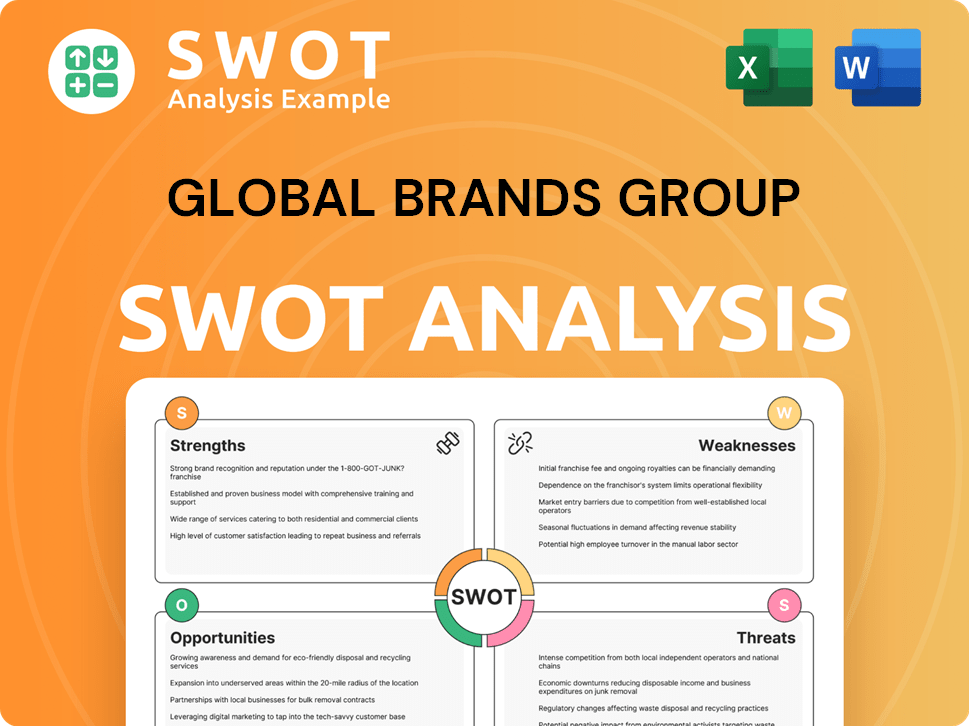
How Has Global Brands Group’s Ownership Changed Over Time?
The ownership of Global Brands Group (GBG) has seen significant changes, particularly due to financial struggles. Initially spun off from Li & Fung Limited and listed on the Hong Kong Stock Exchange in July 2014, the shares were distributed among Li & Fung's existing shareholders. However, the company faced substantial losses, with a US$584 million loss reported in 2020, up from US$388 million in 2019. By June 2021, liabilities exceeded assets, leading to a trading halt by the Hong Kong Stock Exchange.
GBG's financial difficulties resulted in asset sales and a winding-up process. In 2022, Creative Artists Agency (CAA) acquired full ownership of CAA-GBG Global Brand Management Group. Brands like Frye and Spyder were sold to Authentic Brands Group LLC, and the Aquatalia brand was put up for sale. These events dramatically reshaped the ownership landscape of Global Brands Group.
| Event | Date | Outcome |
|---|---|---|
| Spin-off from Li & Fung and IPO | July 2014 | Initial share distribution to Li & Fung shareholders |
| Losses Reported | 2019-2020 | Significant financial losses, impacting the company's stability |
| Trading Halt | June 2021 | Hong Kong Stock Exchange halts trading due to inability to file annual results |
| Chapter 11 Filing (GBG USA) | July 29, 2021 | Subsidiary initiates proceedings, leading to brand sales |
| Liquidation | November 5, 2021 | Formal liquidation ordered by Bermuda Supreme Court |
| CAA Acquisition | 2022 | CAA takes full ownership of CAA-GBG Global Brand Management Group |
As of June 2025, according to PitchBook, Global Brands Group Holding Limited is considered 'Out of Business' with an 'Out of Business' ownership status. The company's headquarters remain in Hong Kong. The winding-up process suggests shareholders are unlikely to receive any distributions. For more information about the company's strategic moves, you can read about the Growth Strategy of Global Brands Group.
Global Brands Group's ownership structure has significantly changed due to financial challenges and liquidation.
- The company's financial difficulties led to asset sales and a winding-up process.
- Major stakeholders, including CAA and Authentic Brands Group, acquired key assets.
- As of June 2025, Global Brands Group is considered out of business.
- Shareholders are unlikely to receive distributions due to liabilities exceeding assets.
Global Brands Group PESTLE Analysis
- Covers All 6 PESTLE Categories
- No Research Needed – Save Hours of Work
- Built by Experts, Trusted by Consultants
- Instant Download, Ready to Use
- 100% Editable, Fully Customizable
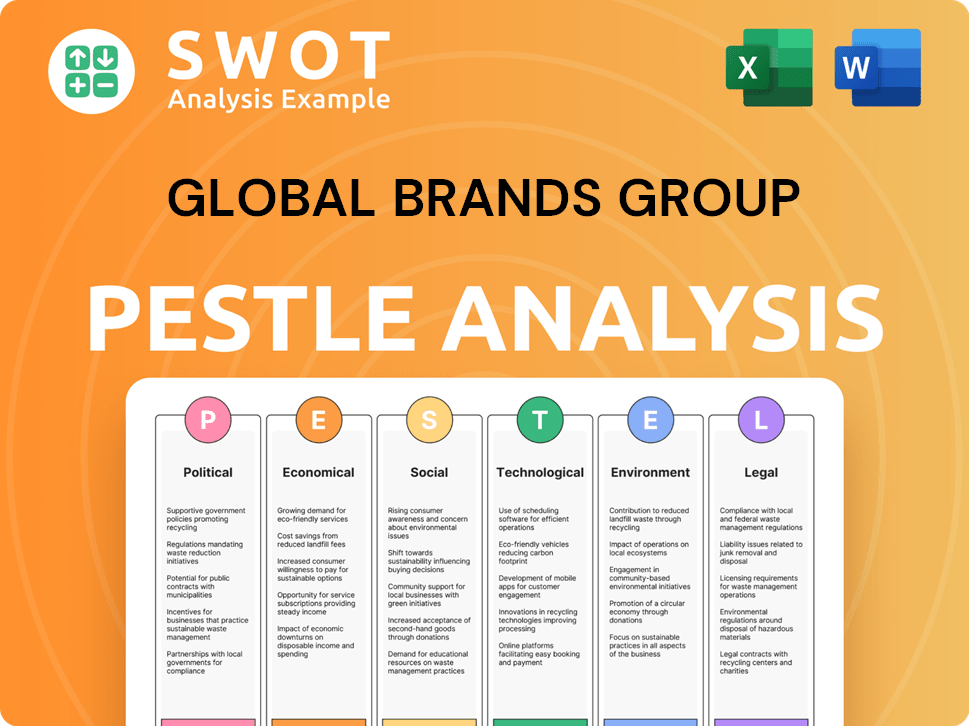
Who Sits on Global Brands Group’s Board?
At the time of its financial decline and subsequent liquidation, the Board of Directors of Global Brands Group Holding Limited, also known as GBG, played a crucial role. As of September 2021, Dr. William Fung Kwok Lun was the Executive Director and Chairman, a position he held since the company's listing in July 2014. He had connections to King Lun Holdings Limited and Fung Holdings (1937) Limited, which were substantial shareholders. Patrick Ho Pak Chuen served as an Executive Director and Chief Operating Officer starting August 10, 2021. Independent Non-executive Directors included Dr. Allan Zeman, who had been on the board since July 2014. Understanding the Marketing Strategy of Global Brands Group is key to assessing the company's past performance.
The decisions made by the board during this period highlight their power, even amidst financial difficulties. For example, the board approved a significant increase in CEO Richard Nixon Darling's remuneration, from US$516,000 in 2019 to US$6,592,000 in 2020, despite the company reporting a loss of US$584 million in 2020. Furthermore, the board decided to initiate winding-up proceedings and applied to the Bermuda Court to appoint a provisional liquidator to restructure the company's debts. This ultimately led to the formal winding-up order in November 2021.
| Director | Role | Start Date |
|---|---|---|
| Dr. William Fung Kwok Lun | Executive Director and Chairman | July 2014 |
| Patrick Ho Pak Chuen | Executive Director and Chief Operating Officer | August 10, 2021 |
| Dr. Allan Zeman | Independent Non-executive Director | July 2014 |
The voting structure of Global Brands Group Holding Limited, as a publicly listed company on the Hong Kong Stock Exchange, generally followed a one-share-one-vote principle. Shareholders could vote in person or by proxy at annual general meetings. However, the company's bye-laws also stipulated that if a share buy-back increased a shareholder's proportionate interest in the voting rights, it would be treated as an acquisition under the Takeovers Code, potentially allowing a shareholder or group of shareholders to consolidate control.
The board's decisions, such as the CEO's salary increase and the winding-up proceedings, demonstrate their significant influence during the company's financial struggles.
- Dr. William Fung Kwok Lun was the Chairman, with connections to major shareholders.
- The voting structure followed a one-share-one-vote principle.
- The board's actions highlight their power even amid financial decline.
- The company faced significant financial losses.
Global Brands Group Business Model Canvas
- Complete 9-Block Business Model Canvas
- Effortlessly Communicate Your Business Strategy
- Investor-Ready BMC Format
- 100% Editable and Customizable
- Clear and Structured Layout
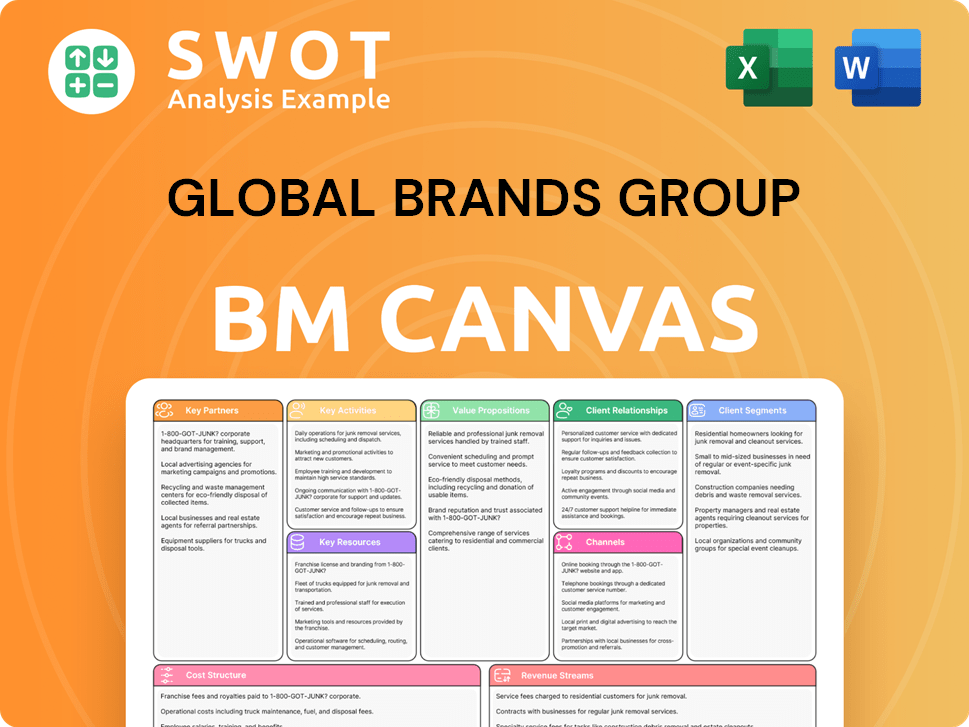
What Recent Changes Have Shaped Global Brands Group’s Ownership Landscape?
Over the past few years, the ownership structure of Global Brands Group (GBG) has undergone a significant transformation. The company, formerly listed publicly, is now in liquidation. The Bermuda Supreme Court issued a winding-up order on November 5, 2021, which was recognized in Hong Kong in 2022. This marked the end of its operational activities and shifted its focus to asset disposal to satisfy creditors. The Global Brands Group's financial difficulties were evident in its financial reports, with an unaudited operating loss of approximately US$222.75 million for the year ending March 31, 2021. Non-cash operating losses, including impairment and other losses, amounted to roughly US$1.49 billion, largely due to Chapter 11 proceedings of its US debtors and asset sales.
Key changes in Global Brands Group ownership involved the sale of major assets and intellectual property. For example, Creative Artists Agency acquired complete ownership of the CAA-GBG Global Brand Management Group in 2022. The company sold its Aquatalia brand for about US$3.3 million in October 2021 to Centric Brands International Europe to pay off debt. Assets related to the Frye and Spyder brands were previously sold to Authentic Brands Group LLC. The company's shares were suspended from trading on the Hong Kong Stock Exchange in July 2021 and were subsequently delisted. This situation signifies a complete shift, from public ownership to a state where liquidators manage remaining assets for creditors, with shareholders unlikely to receive any distributions. For more insights into the company's target market, you can read this article Target Market of Global Brands Group.
The overarching trend in Who owns Global Brands Group is one of dissolution and asset divestment. The company's focus has been on liquidating assets to meet its financial obligations rather than pursuing strategic investments or traditional ownership changes. The delisting of shares and the winding-up process underscore a significant shift away from its prior corporate structure.
Winding-up order issued by the Bermuda Supreme Court on November 5, 2021, leading to asset disposal.
Unaudited operating loss of approximately US$222.75 million for the year ended March 31, 2021, significantly impacting the company's financial health.
Sale of Aquatalia brand for approximately US$3.3 million in October 2021, along with assets of Frye and Spyder brands.
Creative Artists Agency acquired full ownership of the CAA-GBG Global Brand Management Group in 2022, changing the brand portfolio.
Global Brands Group Porter's Five Forces Analysis
- Covers All 5 Competitive Forces in Detail
- Structured for Consultants, Students, and Founders
- 100% Editable in Microsoft Word & Excel
- Instant Digital Download – Use Immediately
- Compatible with Mac & PC – Fully Unlocked
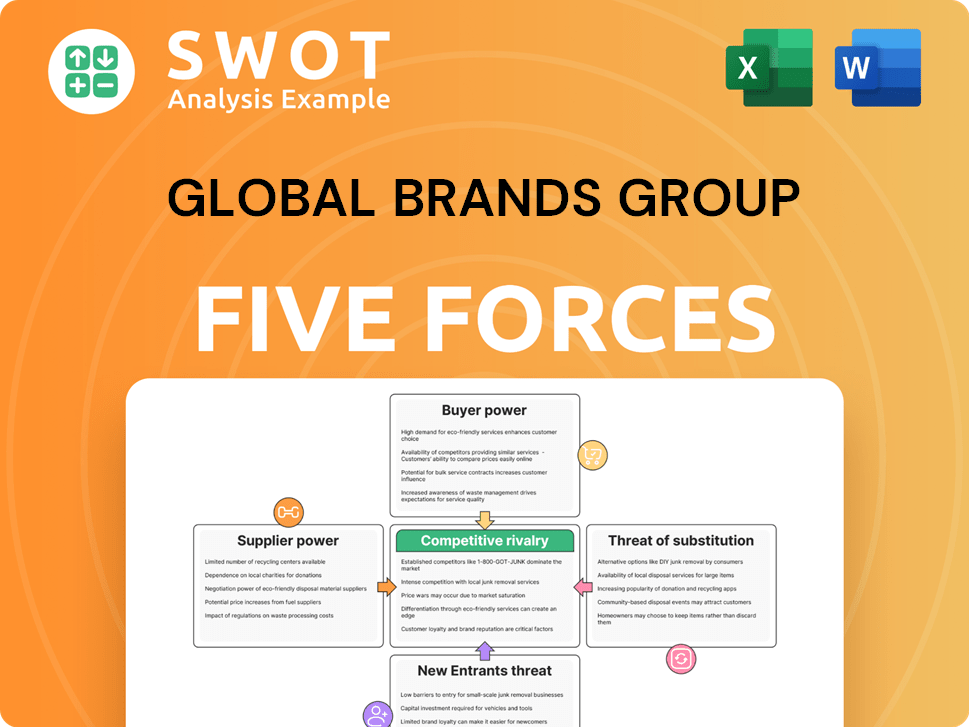
Related Blogs
- What are Mission Vision & Core Values of Global Brands Group Company?
- What is Competitive Landscape of Global Brands Group Company?
- What is Growth Strategy and Future Prospects of Global Brands Group Company?
- How Does Global Brands Group Company Work?
- What is Sales and Marketing Strategy of Global Brands Group Company?
- What is Brief History of Global Brands Group Company?
- What is Customer Demographics and Target Market of Global Brands Group Company?
Disclaimer
All information, articles, and product details provided on this website are for general informational and educational purposes only. We do not claim any ownership over, nor do we intend to infringe upon, any trademarks, copyrights, logos, brand names, or other intellectual property mentioned or depicted on this site. Such intellectual property remains the property of its respective owners, and any references here are made solely for identification or informational purposes, without implying any affiliation, endorsement, or partnership.
We make no representations or warranties, express or implied, regarding the accuracy, completeness, or suitability of any content or products presented. Nothing on this website should be construed as legal, tax, investment, financial, medical, or other professional advice. In addition, no part of this site—including articles or product references—constitutes a solicitation, recommendation, endorsement, advertisement, or offer to buy or sell any securities, franchises, or other financial instruments, particularly in jurisdictions where such activity would be unlawful.
All content is of a general nature and may not address the specific circumstances of any individual or entity. It is not a substitute for professional advice or services. Any actions you take based on the information provided here are strictly at your own risk. You accept full responsibility for any decisions or outcomes arising from your use of this website and agree to release us from any liability in connection with your use of, or reliance upon, the content or products found herein.